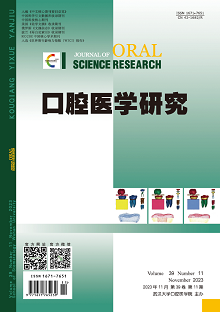|
|
Osteogenic Properties of Polyetheretherketone Biocomposited by Biphasic Calcium Phosphate
GU Teng, LUO Guisheng, XU Xianzhi, LI Junjun, WANG Xuran, YUAN Changyong, WANG Penglai
2023, 39(11):
1012-1017.
DOI: 10.13701/j.cnki.kqyxyj.2023.11.014
Objective: To investigate the osteogenic properties of polyetheretherketone modified by the biphasic calcium phosphate. Methods: The biphasic calcium phosphate/polyetheretherketone composites processed by the composite process were used as the experimental group and polyetheretherketone as the control group. Scanning electron microscopy, X-ray photoelectron spectroscopy, and contact angle measurement were used to examine the surface morphology, chemical elemental composition, and hydrophilicity of the samples. Rat bone marrow mesenchymal stem cells were co-cultured with the samples, and the proliferation performance of the cells was detected by CCK-8 assay; the expression of osteogenic genes OCN, ALP, BMP-2, RUNX2, and SP7 were detected by real-time fluorescence quantitative PCR. In addition, two groups of implants were implanted into the distal femur of rats by establishing a rat femoral implant model, and the osseointegration of the implants was analyzed by Micro-CT. Results: Although the surface morphology of the polyetheretherketone material modified by biphasic calcium phosphate did not change significantly, calcium and phosphorus, which were essential for bone growth, were successfully introduced and the surface hydrophilicity of the samples was improved (P<0.01). The modified polyetheretherketone significantly promoted cell proliferation activity (P<0.01) and showed good biosafety; and it also improved the expression of the osteogenic genes ALP, BMP-2, OCN, RUNX2, and SP7 (P<0.05). In vivo experiments in rats, the surface of the biphasic calcium phosphate/polyetheretherketone implants possessed more and denser new bone formation (P<0.01). Conclusion: Polyetheretherketone modified with biphasic calcium phosphate significantly improved the bioactivity of the polyetheretherketone surface, enhanced hydrophilic properties, and was able to promote osteoblast differentiation and proliferation and enhance the osseointegration properties of the implants.
References |
Related Articles |
Metrics
|

